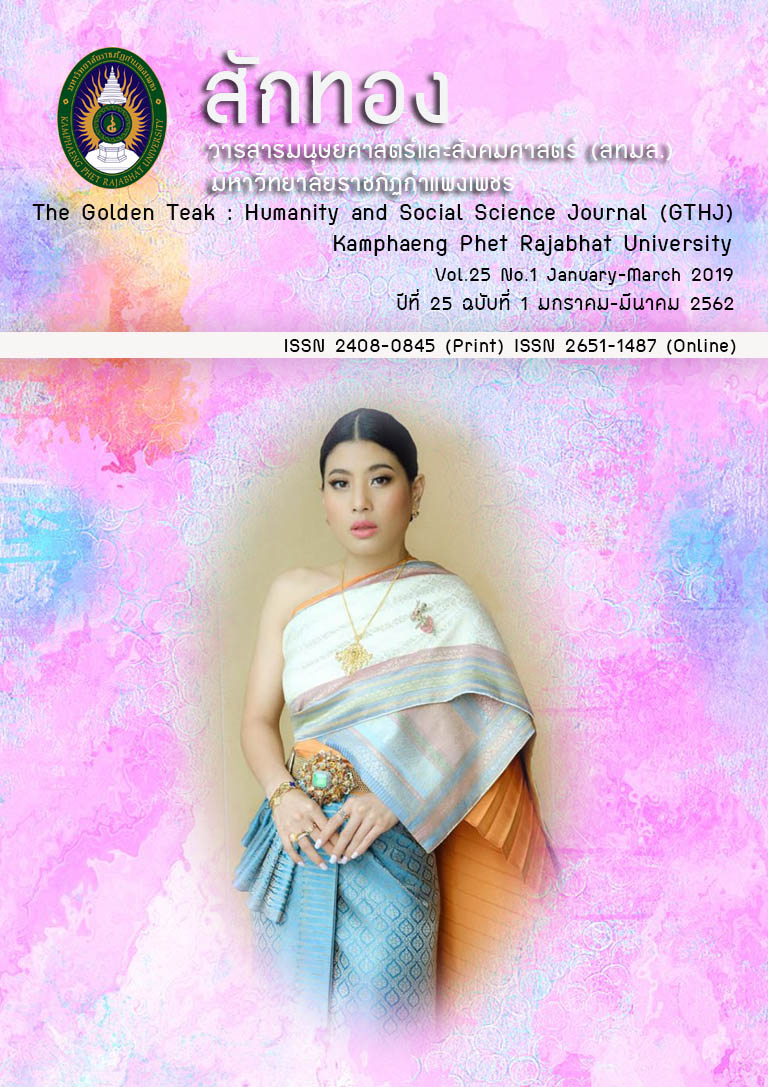Factors Affecting Tourists’ Behavior Towards Shopping in Mae Sot Special Economic Zone, Tak Province
Main Article Content
Abstract
This study aims to study the tourist behavior in shopping tourism in the Mae Sot Special Economic Zone, Tak Province, and to study investigate factors and relationship of tourism factors in developing Mae Sot special economic zone. A stratified random sampling group focused on 400 tourists who came to Mae Sot Special Economic Zone, Tak Province. The research instrument was a tourist behavior questionnaire. The finding on the factors related to tourists’ behavior towards shopping can be sorted from the most to the least affected factors as follows; the expectation, motivation, expense and length of stay were what most affected factors of tourists’ behavior which has the higher than the mean, and the perception had the medium level. Furthermore the results of 5 factors were tested by using relation test (SPSS Program). The results were positive as they were shown that they had statistical significance at the level of .01, and the correlation coefficient of variable was found at the level of 0.35 to 0.74.
Article Details
บทความที่ได้รับการตีพิมพ์เป็นลิขสิทธิ์ของวารสาร สักทอง : วารสารมนุษยศาสตร์และสังคมศาสตร์ สถาบันวิจัยและพัฒนา มหาวิทยาลับราชภัฏกำแพงเพชร
ข้อคิดเห็นใดๆ ที่ปรากฎในวารสารเป็นวรรณกรรมของผู้เขียนโดยเฉพาะ ซึ่งมหาวิทยาลัยราชภัฏกำแพงเพชรและบรรณาธิการไม่จำเป็นต้องเห็นด้วย
References
Chon, K. (1989). Understanding recreational travelers’ motivation, attitude and satisfaction. The Tourist Review, 44(1), 3-7.
Francken, D.A. & van Raaij, W.F. (1981). Satisfaction with leisure time activities. Journal of Leisure Research, 13(4), 337-352.
Iso-Ahola, S. (1982). Toward a social psychology theory of tourism motivation. Annals of Tourism Research, 12, 256-262.
Kast, F.E. & Rosenzweig, J.E. (1985). Organization and Contingency Approach. (4 th ed.). Singapore : McGraw-Hill.
Kaweya, S. (2004). New Public Relations : Integrated Corporate Communication. Bangkok : O. S. Printing House.
Kazuzuru, B. (2014). Determinants of Tourist Length of Stay in Tanzania. International Journal of Business and Social Science, 9(1), 204-214.
Klenosky, D.B. (2002). The pull of tourism destinations : A means-end investigation. Journal of Travel Research, 40(2), 385-395.
Kotler, P. (2001). A framework for marketing management. Upper Saddle River, New Jersey : Prentice.
Lee, G., O’Leary, J.T., Lee, S.H. & Morrison, A. (2002). Comparison and contrast of push and Pull Motivational effects on trip behavior : An application of a multi nominal logistic regression model. Tourism Analysis, 7, 89-104.
Martinez-Garcia, E. & Raya, J.M. (2008). Length of stay for low-cost tourism. Tourism Management, 29(6), 1064-1075.
Ministry of Tourism and Sports. (2015). Tourism Strategy of Thailand 2015-2017. [Online]. Available : http://www.mots.go.th/ewt_dl_link.php?nid=7114. [2015, August 4].
_______. (2015). Thai Tourist Statistics. [Online]. Available : http://www.tourism.go.th/view/1. [2016, August 12].
Mowen, J.C. & Minor, M. (1998). Consumer Behavior. (5 th ed.). New Jersey : Prentice-Hall.
Office of the National Economics and Social Development Board. (2016). Direction of economic development plans and national No. 12 . [Online]. Available :
http://www.nesdb.go.th/ewt_ news.php?nid=6101&filename= index. [2016, December 9].
Oliver, R.L. (1980). A cognitive model of the antecedents and consequences of satisfaction decisions. Journal of Marketing Research, 17, 46-49.
Phetsati, P. (2015). The Strategies of Sustainable Tourism Management of Kamphaeng Phet Province. The Golden Teak : the Humanities and Social Sciences Journal, 21(2), 173-186.
Pimonsompong, C. (2005). Plannin and Marketing Development. Bangkok : Kasetsart University.
Pizam, A., Neuman, Y. & Reichel, A. (1979). Tourist satisfaction uses and misuses. Annals of Tourism Research, 6(2), 195-197.
Sareerat, S., et al. (1998). Marketing strategy and marketing management. Bangkok : Teera Film and SITEX.
Schiffman, L.G. & Kanuk, L.L. (1991). Consumer Behavior. (4 th ed.) New Jersey : Englewood Cliffs.
Sittilert, T. (2015). Special Articles on Special Economic Zones in 5 Provinces 6 Areas to Support AEC ASEAN Information Center PR Department. [Online]. Available : http://www.aseanthai.net/ewt_news.php?nid=4393&filename=index. [2016, August 10].
Spotts, D.M. & Mahoney, E.M. (1991). Segmenting visitors to a destination region based on The Volume of their expenditure. Journal of Travel Research, 29(4), 24-31.
Timothy, D.J. & Butler, R.W. (1995). Cross-border shopping: A North American perspective. Annals of Tourism Research. Vol. 22, No. 1, pp. 16-34.
Turner, W.L. & Reisinger, Y. (2001). Shopping satisfaction for domestic tourists. Journal of Retailing and Consumer Services, 8, 15-27.
Uysal, M. & Jurowski, C. (1994). Testing the push and pull factors. Annals of Tourism Research, 21(4), 844-846.
Vanichbuncha, K. (2006). Statistics for research. (2 rd ed.). Bangkok : Chulalongkorn University.
Yamane, Taro. (1973). Statistics: an introductory analysis. New York : Harper & Row.
Yuan, S. & McDonald, C. (1990). Motivational Determinants of International Pleasure Time. Journal of Travel Research, 29(1), 42-44.


